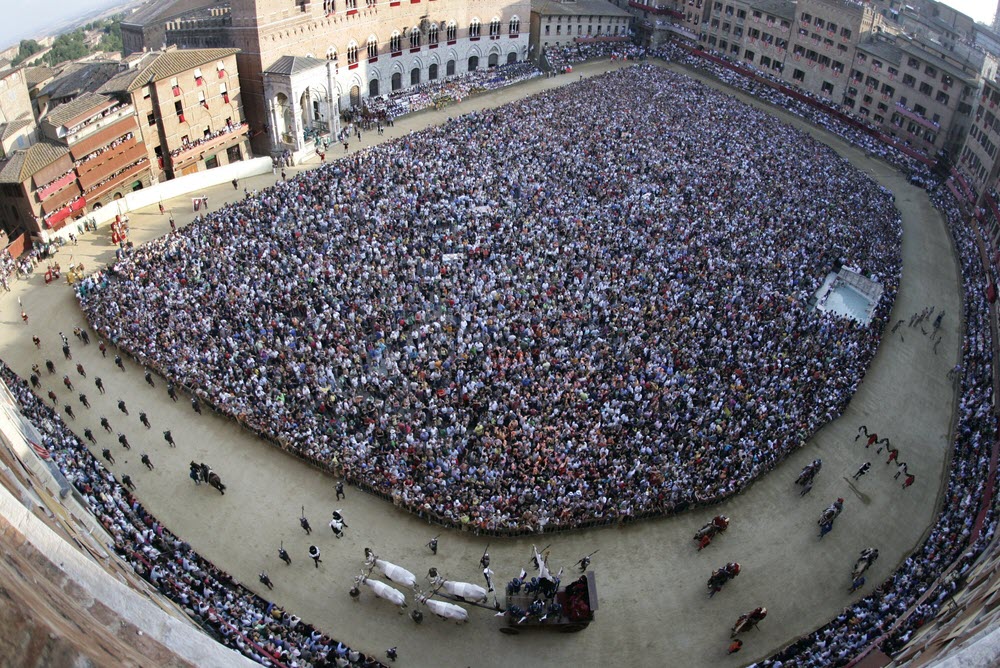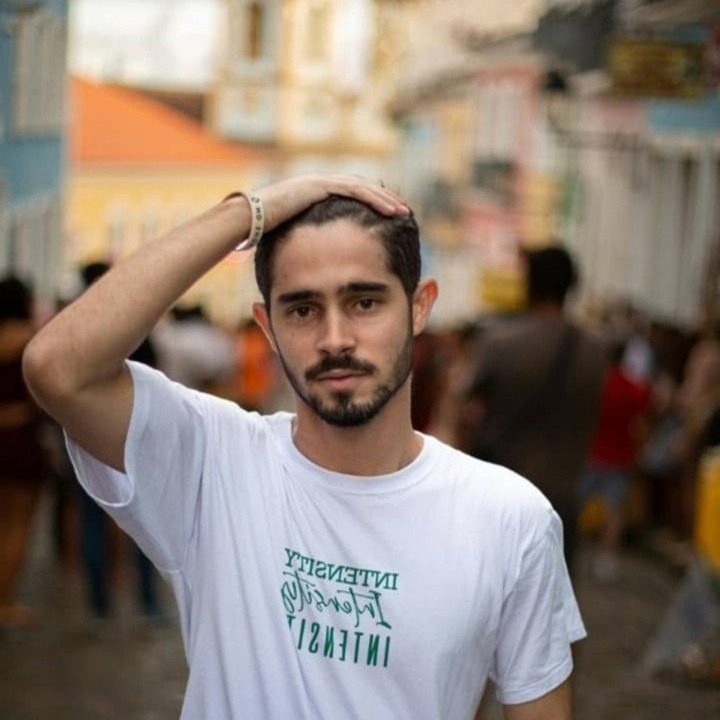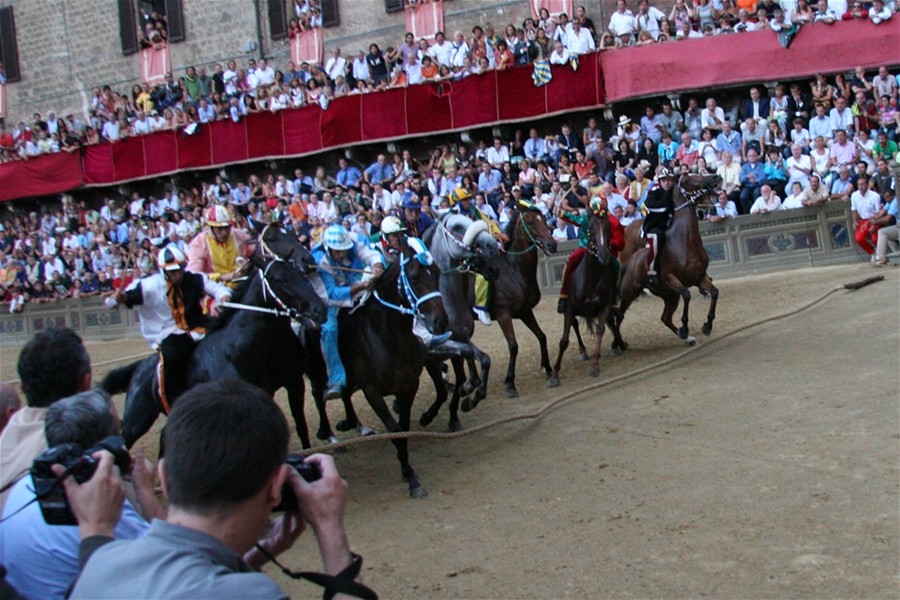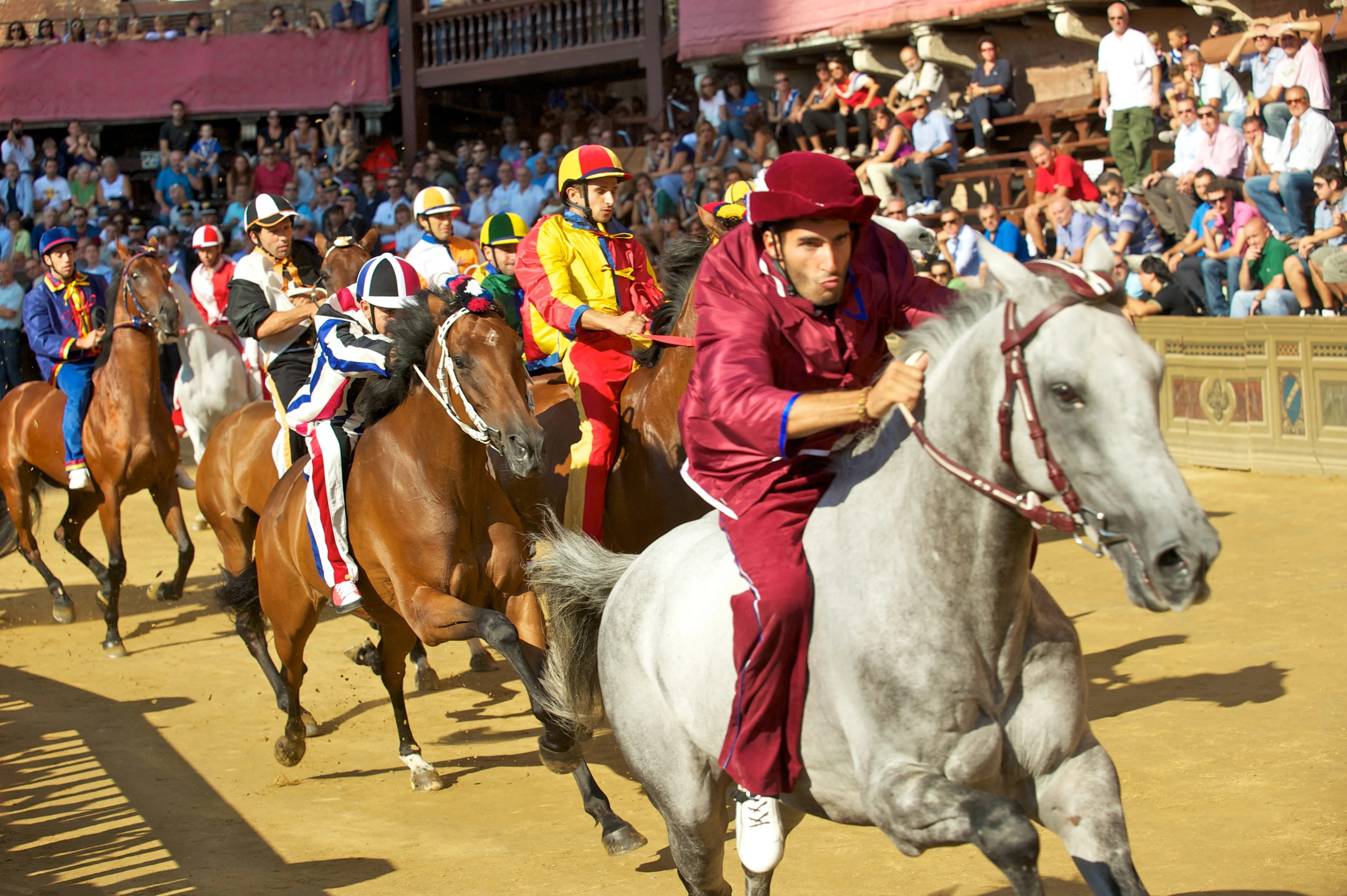Palio Di Siena - History And Traditions Of Italy's Famous Horse Race
Palio Di Siena, the most famous horse race, is a vibrant and historic event held twice a year in Siena's Piazza del Campo. This thrilling race, steeped in medieval tradition, showcases intense rivalry between Siena's districts, offering spectators a unique and unforgettable cultural experience.
Author:Sophia HarperReviewer:Finn WildeAug 06, 20241.8K Shares74.6K Views

Palio Di Siena, Italy's most renowned horse race, captivates visitors with its deep-rooted traditions and vibrant atmosphere. Held twice a year on July 2nd and August 16th, this historic event transforms Siena's Piazza del Campo into a thrilling arena of competition. Originating in the 17th century, Il Palio is a fierce contest between Siena's contrade, or districts, each represented by a horse and jockey, vying for victory and honor.
The excitement of Siena Il Palio extends beyond the race itself, encompassing days of pageantry, parades, and celebrations. The city comes alive with colorful banners, medieval costumes, and the fervent passion of locals and tourists alike. Witnessing Siena Il Palio offers an immersive experience of Italian culture and history, where the spirit of rivalry and community pride is palpable at every corner.
What Is Il Palio Di Siena
It is Italy's best-known horse race,held twice each year on July 2 and August 16 in the city's main piazza, pictured above on a normal summer's day and below on race day. Ten horses and their colorfully clad riders represent ten of Siena's 17 districts, but before the race - which is just three brutal laps - there is a lengthy ceremony and procession celebrating Siena's medieval past.
Spectators for the Palio start to arrive in the morning, taking positions standing in the center, paying for seats in the stands (bleachers), or buying extravagant box seats. Paid seating sells out way in advance so tourists must book beforehand or be prepared to stand most of the day in one overheated location. Before the race locals put on a spectacular pageant, including flag-wavers in medieval costumes and mounted horse police charging around the dirt track. At around 7 pm the race starts, three times around the dirt-covered Piazza del Campo.
Riders not only use their whips - which are made of dried bull's penises - on their mounts, but also other horses. In consequence, taken together with bareback seating, a slippery track surface that slopes in places, a tight circuit, and testosterone overload, there are many accidents for both riders and horses. A riderless horse can win the race so long as its head ornament is still in place. The winner of the race gets a hand-painted silk banner (a palio), and the crowd goes wild - particularly citizens of the winning district, but rival punch-ups are not uncommon.
Comparisons Between Il Palio And Canada's Calgary Stampede
It's an F2 experience (fun with frustration) living in the Third World (a developed country with many undeveloped characteristics). Italy is First World and very attractive in many respects – culture in general, food and drink, autostrada, design, friendliness of the people, history, geographic beauty, and so on – but Third World in many areas that are essential to life in the 21st century – among others the political system, judicial system, financial system, and communications systems without touching on the mule track roads away from the central highways and restrictive retail practices which require careful planning for shopping expeditions. It's a bi-polar life in Italy for travelers and foreign residents.
An interesting contrast between the two worlds and their respective organization, for example, is Il Palio in Italy's Siena vs. Canada's Calgary Stampede.Both are annual events in which the respective towns become intimately involved (in Siena the main square is taken over for Il Palio, in Calgary the whole city dresses up for the rodeo, and the main streets are closed for the kick-off parade) with a long tradition (the first going back centuries, the second about a hundred years), a festive atmosphere, intense rivalry and bareback riders on horses who may fall off (four out of ten at Il Palio this year). Both have television coverage a dedicated following and considerable skills.
So, What Are The Differences
Location
Siena uses existing premises (the square) and is redolent of the past, Calgary has purpose-built facilities (with transportation to/from the site as well as extensive vehicle parking) and reflects the present
Duration
Il Palio (the race) lasts a little over a minute, the Stampede covers a week with an intense program of activities from bull riding through bronco busting to wagon races every day
Participants
The cowboys and cowgirls are mainly North American professionals who ply the rodeo circuit (with Calgary, Houston, and Las Vegas being the star attractions), while riders in Siena represent their local villages.
Gear
Cowboys dress much alike and bring their kit, Il Palio riders wear their respective medieval village colors with body armor and are given their whips as they enter the square (presumably to avoid unfair advantage), (the horses/teams are named after animals such as Ostrich or things such as Tower so the commentators make remarks like “Giraffe has the advantage over Panther”).
Commerce
Il Palio is a tourist/local attraction not driven by pecuniary interest, the Stampede is a very commercial enterprise though admittedly with a community-oriented end.
Timing
The Stampede is a slick, finely tuned event with precise timing barring major accidents (such as a chuck wagon turning over and seriously hurting its driver or its horses) and 21st-century razzmatazz (e.g. fireworks). The start of Il Palio is in the lap of the gods as ten highly strung horses have to enter a restricted space between two ropes; when at least the head of the last rider has entered the starter drops one rope to begin the race.
Incidentally, this means that the final rider can play a hugely tactical game by going to the line when all the other horses are at sixes and sevens but it also unpredictably delays the start, 45 minutes in 2008.
Reward
At the end of a week of the Stampede, the winning cowboys can walk away with $100,000; at the end of Il Palio, the winner is lucky to retain his whip as hat, shirt, etc. are frequently ripped off by the souvenir hunting crowd. The inhabitants from the winning Italian village then go off to church to give thanks for their victory - after scuffling with rivals, of course.
Public
The audience at the Stampede is kept at a safe distance from all proceedings; the public at Il Palio climbs over the laughably low railings during the second lap of the race and some are inevitably knocked down and trampled.
Television
If you’re bored, you watch the Stampede on TV; unless you like waiting in a mob you’re better off watching Il Palio on TV, getting repeats of the action from countless different angles, in slow motion, etc.
Siena Il Palio - FAQs
What Is The Significance Of Siena Il Palio?
Il Palio is a symbol of Siena's rich history and community pride. It represents centuries-old rivalries between the contrade and is a major cultural event that attracts visitors from around the world.
How Long Does The Race Last?
The actual race is very short, typically lasting about 90 seconds as the horses complete three laps around the Piazza del Campo.
How Are The Horses And Jockeys Chosen?
Horses are selected through a lottery system, and each contrada then assigns a jockey to their horse. Jockeys often receive extensive training and can be hired from outside Siena.
What Are The Contrade?
Contrade are the 17 districts of Siena, each with its own emblem, colors, and long-standing traditions. Only 10 contrade participate in each race, chosen through a rotation system and additional lottery.
Is Siena Il Palio Dangerous?
Yes, Siena Il Palio is known for its intense and sometimes dangerous nature. The track is challenging with tight turns, and falls are common. Both jockeys and horses face significant risks.
Can Tourists Attend Siena Il Palio?
Yes, tourists are welcome to attend. The central area of the Piazza del Campo is free to enter but can be very crowded. For a better view, you can purchase tickets for seats on balconies or in grandstands.
What Other Events Are Associated With Siena Il Palio?
In the days leading up to the race, there are various events including the drawing of lots for the horses, trial runs, and the historic parade known as the Corteo Storico.
How Do Locals Celebrate Siena Il Palio?
Locals celebrate with immense passion and community spirit. Each contrada holds its celebrations, feasts, and rituals, both before and after the race, regardless of the outcome.
Final Words
Siena's Il Palio is an amateur event steeped in history and local factionalism, brief in execution but long in build-up, uncomfortable and dangerous for (some) spectators, hazardous for all riders and deeply dissatisfying for all but the winner (there are no runner up prizes), and typically European in organization and purpose (regional pride).
The Calgary Stampede is a modern-day version of a traditional pastime with a multiplicity of attractions, activities, and participants from many countries, customized for a mobile world seeking instant gratification and motivated by moolah, comfort, and convenience.
All arrangements are unabashedly North American, carefully choreographed, and run with Swiss-like precision. Local Italian dignitaries and the heads of the village teams take place of honor at Il Palio, and Canadian corporate entertainment suites have pole positions at the Stampede.

Sophia Harper
Author
Sophia Harper’s photography acts as a portal to the soul of the places she visits. Drawn to South America’s landscapes and cultures, she has spent years capturing everything from the majesty of ancient ruins to the vibrancy of urban streets.
Sophia’s work isn’t just about documenting moments; it’s about evoking the emotions and stories behind them. A dedicated photographer, she has worked with local communities across South America to capture their rich cultural narratives through her lens.

Finn Wilde
Reviewer
For Finn Wilde, the wilderness is more than just a destination - it’s a way of life. Over the past decade, he has led multiple expeditions in some of the world’s most remote regions, from the icy fjords of Greenland to the rugged trails of Patagonia.
Finn emphasizes sustainability in all of his adventures, helping participants connect with nature while promoting responsible exploration. His expeditions inspire individuals to explore the great outdoors while fostering a deep respect for the environment.
Latest Articles
Popular Articles

